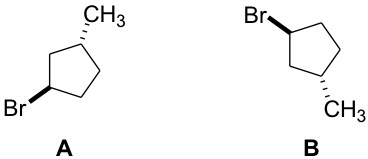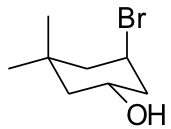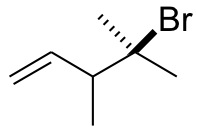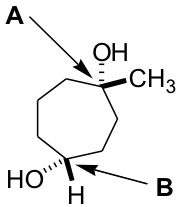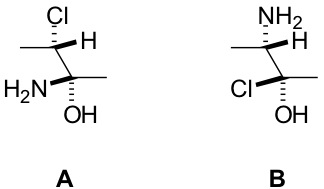Take This Easiest Chemical Bonding Trivia Questions!

Take This Easiest Chemical Bonding Trivia Questions if you are looking for a chance to test out just how much you understand about the different types of chemical bonds that exist in a compound. If you have not studied enough, the quiz will tell you which parts of the topic you need to consider more on. Do give it a try and all the best!
- 1.
What types of orbitals are used to make bond A?
- A.
Sp2-sp3
- B.
Sp3-sp3
- C.
Sp2-sp2
- D.
Sp2-sp
Correct Answer
B. Sp3-sp3Explanation
The correct answer is sp3-sp3. In this type of bond, two atoms each contribute one sp3 hybrid orbital to form a sigma bond. This type of bond is commonly found in molecules with tetrahedral geometry, such as methane (CH4) or ethane (C2H6). The sp3 hybrid orbitals are formed by the combination of one s orbital and three p orbitals, resulting in four hybrid orbitals that are arranged in a tetrahedral geometry around the central atom.Rate this question:
-
- 2.
How many sigma bonds are there in the compound above?
- A.
9
- B.
10
- C.
11
- D.
13
Correct Answer
C. 11Explanation
The compound in question likely contains multiple carbon atoms, each of which can form four sigma bonds. Since there are 11 sigma bonds in total, it suggests that there are three carbon atoms in the compound, each forming four sigma bonds, and one additional sigma bond between two other atoms.Rate this question:
-
- 3.
Which of the following represents the ground state electron configuration of Nitrogen?
- A.
1s2 2s2 2p5
- B.
1s2 2s2 2p6
- C.
1s2 2s2 2p3
- D.
1s2 2s2 2p4
Correct Answer
C. 1s2 2s2 2p3Explanation
The ground state electron configuration of an atom represents the arrangement of electrons in its lowest energy level. Nitrogen has an atomic number of 7, which means it has 7 electrons. The electron configuration of Nitrogen can be determined by filling up the orbitals in order of increasing energy. The first two electrons fill the 1s orbital, the next two fill the 2s orbital, and the remaining three fill the 2p orbital. Therefore, the correct ground state electron configuration for Nitrogen is 1s2 2s2 2p3.Rate this question:
-
- 4.
How many non-bonding electrons are present in compound A? Assume all atoms are neutral.
- A.
10
- B.
12
- C.
7
- D.
6
Correct Answer
B. 12Explanation
In compound A, the number of non-bonding electrons refers to the number of electrons that are not involved in any chemical bonds. Since the question states that all atoms are neutral, we can assume that the compound does not have any charged ions. Therefore, the number of non-bonding electrons can be determined by subtracting the total number of electrons involved in bonding from the total number of valence electrons. The correct answer of 12 suggests that there are 12 non-bonding electrons present in compound A.Rate this question:
-
- 5.
How many valence electrons does Phosphorous (P) have?
- A.
15
- B.
13
- C.
5
- D.
3
Correct Answer
C. 5Explanation
Phosphorus (P) is located in group 15 of the periodic table, which means it has 5 valence electrons. Valence electrons are the electrons in the outermost energy level of an atom, and they determine the element's chemical properties and reactivity. Therefore, the correct answer is 5.Rate this question:
-
- 6.
What types of orbitals are used to make bond A in the structure above?
- A.
Sp2-sp2
- B.
Sp3-sp3
- C.
Sp2-sp3
- D.
Sp2-sp
Correct Answer
C. Sp2-sp3Explanation
The correct answer is sp2-sp3. In the structure above, bond A is formed between two atoms. One of the atoms is hybridized with sp2 orbitals, while the other atom is hybridized with sp3 orbitals. This means that the bond is formed between an atom with three sigma bonds and an atom with four sigma bonds.Rate this question:
-
- 7.
How many sigma bonds are there in the compound above?
- A.
17
- B.
7
- C.
11
- D.
15
Correct Answer
D. 15Explanation
The compound above contains 15 sigma bonds. A sigma bond is formed when two atomic orbitals overlap end-to-end, allowing for the sharing of electrons between atoms. In the given compound, there are multiple atoms bonded together, and each bond contributes one sigma bond. By counting the number of bonds in the compound, we can determine that there are 15 sigma bonds present.Rate this question:
-
- 8.
How many non-bonding electrons are present in compound A? Assume all atoms are neutral.
- A.
10
- B.
6
- C.
7
- D.
12
Correct Answer
A. 10Explanation
Compound A has 10 non-bonding electrons. Non-bonding electrons are the electrons that are not involved in any chemical bond. In order to determine the number of non-bonding electrons in compound A, we need to know the electron configuration of its constituent atoms. Without this information, it is not possible to provide a more detailed explanation.Rate this question:
-
- 9.
Assign values to bond angles A and B in the structure above.
- A.
A = 120°, B = 180°
- B.
A = 109.5°, B = 120°
- C.
A = 120°, B = 120°
- D.
A = 109.5°, B = 109.5°
Correct Answer
B. A = 109.5°, B = 120°Explanation
The given structure is likely a molecule with a trigonal bipyramidal geometry. In this geometry, the bond angles around the central atom are typically 90°, 120°, and 180°. The answer A = 109.5°, B = 120° is consistent with this geometry. The angle A of 109.5° suggests the presence of a lone pair on the central atom, which causes a slight compression of the bond angles. The angle B of 120° is one of the expected bond angles in a trigonal bipyramidal structure.Rate this question:
-
- 10.
Determine the orbital hybridization states for atoms A, B, and D.
- A.
A-sp2, B-sp2, D-sp2
- B.
A-sp3, B-sp2, D-sp3
- C.
A-sp, B-sp3, D-sp2
- D.
A-sp2, B-sp2, D-sp3
Correct Answer
D. A-sp2, B-sp2, D-sp3Explanation
For atom A, the nitrogen has a lone pair that wants to delocalize its electrons, creating a resonance structure. Thus, a double bond would be formed to that nitrogen and you'd get an sp2 orbital.Rate this question:
-
- 11.
Which of the following protons (HA, HB, and HD) is most acidic?
- A.
They all have the same acidity.
- B.
HD
- C.
HB
- D.
HA
Correct Answer
C. HBExplanation
If you remove HB, you'd be left with a carbanion at that spot. Because there would then be a negative charge adjacent to a double bond, there can be electron delocalization, resulting in resonance structures, that would stabilize the overall product. Thus, HB is most acidic.Rate this question:
-
- 12.
What are the formal charges on atoms A and B, respectively in the above structure?
- A.
A = +1, B= -1
- B.
A = +1, B= +1
- C.
A = -1, B= 0
- D.
A = 0, B= +1
Correct Answer
D. A = 0, B= +1Explanation
In the above structure, atom A has a formal charge of 0 because it has 4 valence electrons and is bonded to 4 other atoms, satisfying the octet rule. Atom B has a formal charge of +1 because it has 6 valence electrons and is bonded to only 3 other atoms, resulting in a deficiency of one electron.Rate this question:
-
- 13.
What are the formal charges on atoms A and B, respectively in the above structure?
- A.
A = 0, B = 0
- B.
A = +1, B = 0
- C.
A = +1, B = +1
- D.
A = -1, B = -1
Correct Answer
B. A = +1, B = 0Explanation
In the above structure, the formal charge on atom A is +1 because it has one fewer valence electron than its neutral state. The formal charge on atom B is 0 because it has the same number of valence electrons as its neutral state.Rate this question:
-
- 14.
Rank molecules A, B, and D in order of increasing pKa of the most acidic proton in each.
- A.
A, B, D.
- B.
D, A, B.
- C.
D, B, A.
- D.
B, D, A.
Correct Answer
C. D, B, A.Explanation
Across the periodic table, electronegativity increases, and because of that, pKa increases, meaning B would have a lower pKa than A. As for D, if you remove the hydrogen from the alcohol, you get electron delocalization with the adjacent double bond on the other oxygen. Thus, D has a lower pKa than B and A.Rate this question:
-
- 15.
Acidity increases with increasing atom size.
- A.
True
- B.
False
Correct Answer
A. TrueExplanation
As you go down the periodic table, atom get larger. Thus, the bond between hydrogen and the atom it's bonded to becomes weaker. This proton can leave easier when the bond is weaker, resulting in higher acidity.Rate this question:
-
- 16.
Acidity across the periodic table decreases with electronegativity.
- A.
True
- B.
False
Correct Answer
B. FalseExplanation
False. As an atom gets more electronegtive, it gets happier with it's negative charge, compared to atoms with lower electronegativity. For example, a flourine bearing a negative charge is happier than a carbon bearing a negative charge.Rate this question:
-
- 17.
A hydrogen bonded to a SP2 carbon is more acidic than a hydrogen bonded to an SP3 carbon.
- A.
True
- B.
False
Correct Answer
A. TrueExplanation
This is true, because alkynes are more stable than alkenes are more stable than alkanes.Rate this question:
-
- 18.
Rank the labeled protons in order of increasing pKa.
- A.
D, A, B
- B.
B, A, D
- C.
D, B, A
- D.
A, B, D
Correct Answer
C. D, B, AExplanation
The answer D, B, A is correct because pKa is a measure of the acidity of a proton, with a lower pKa indicating a stronger acid. Therefore, the proton labeled D has the highest pKa, followed by the proton labeled B, and finally the proton labeled A has the lowest pKa.Rate this question:
-
- 19.
Rank the labeled protons in order of increasing pKa.
- A.
D, A, B
- B.
D, B, A
- C.
A, B, D
- D.
B, A, D
Correct Answer
B. D, B, AExplanation
The pKa value of a compound indicates the acidity of its protons. A lower pKa value indicates a stronger acid. In this case, the correct answer is D, B, A. This means that proton D is the least acidic, followed by proton B, and proton A is the most acidic.Rate this question:
-
- 20.
What functional groups are present in the molecule?
- A.
An amide and an ester
- B.
A ketone and a nitrile
- C.
An amide and an ether
- D.
An amine and an alcohol
Correct Answer
C. An amide and an etherExplanation
The molecule contains an amide functional group, which is characterized by a carbonyl group (C=O) bonded to a nitrogen atom. Additionally, it contains an ether functional group, which is characterized by an oxygen atom bonded to two alkyl or aryl groups.Rate this question:
-
- 21.
Which of the structures contains an aldehyde functional group?
- A.
A only
- B.
D only
- C.
B and D only
- D.
E only
Correct Answer
A. A onlyExplanation
Structure A contains an aldehyde functional group. An aldehyde is characterized by a carbonyl group (C=O) bonded to a hydrogen atom (H). In Structure A, there is a carbonyl group bonded to a hydrogen atom, indicating the presence of an aldehyde functional group. Structures D and E do not have a carbonyl group bonded to a hydrogen atom, so they do not contain an aldehyde functional group. Structure B does not have a carbonyl group at all, so it also does not contain an aldehyde functional group.Rate this question:
-
- 22.
What functional groups are present in this molecule?
- A.
An aldehyde and a amine
- B.
An amine and an ester
- C.
An amide and an ether
- D.
An ester and an ether
Correct Answer
C. An amide and an etherExplanation
The correct answer is an amide and an ether. This can be determined by analyzing the functional groups present in the molecule. An amide is characterized by the presence of a carbonyl group (C=O) bonded to a nitrogen atom, while an ether is characterized by the presence of an oxygen atom bonded to two carbon atoms.Rate this question:
-
- 23.
Which of the following represents the IUPAC name for compound A?
- A.
3-chloro-4-propylhexane
- B.
5-chloro-3-ethylheptane
- C.
4-propyl-5-chlorohexane
- D.
3-chloro-4-ethylheptane
Correct Answer
D. 3-chloro-4-ethylheptaneExplanation
The compound A has a chlorine atom attached to the third carbon atom and an ethyl group attached to the fourth carbon atom. The longest carbon chain in the compound is heptane, which has seven carbon atoms. Therefore, the correct IUPAC name for compound A is 3-chloro-4-ethylheptane.Rate this question:
-
- 24.
Which of the following structures contains a ketone functional group?
- A.
A only
- B.
A, B, and E only
- C.
B and D only
- D.
A and E only
Correct Answer
D. A and E onlyExplanation
Structures A and E both contain a ketone functional group. A ketone functional group consists of a carbon double bonded to an oxygen atom, with two additional carbon groups bonded to the same carbon atom. In structure A, the carbon atom in the middle has a double bond with the oxygen atom and two additional carbon groups bonded to it, making it a ketone. In structure E, the carbon atom in the middle also has a double bond with the oxygen atom and two additional carbon groups bonded to it, making it another example of a ketone. Therefore, the correct answer is A and E only.Rate this question:
-
- 25.
What is the molecular formula for compound A?
- A.
C6 H12 O2
- B.
C6 H12 O
- C.
C5 H10 O2
- D.
C6 H10 O
Correct Answer
A. C6 H12 O2Explanation
The molecular formula for compound A is C6 H12 O2 because it indicates that the compound contains 6 carbon atoms, 12 hydrogen atoms, and 2 oxygen atoms. This formula provides the exact number and types of atoms present in the compound, allowing for accurate identification and representation.Rate this question:
-
- 26.
Specify the number of secondary carbons in compound A.
- A.
2
- B.
4
- C.
1
- D.
3
Correct Answer
A. 2Explanation
Compound A has 2 secondary carbons. This means that there are 2 carbon atoms in the compound that are bonded to two other carbon atoms. The other carbons in the compound are either bonded to only one carbon atom (primary carbons) or three or more carbon atoms (tertiary carbons).Rate this question:
-
- 27.
Which of the following is NOT a valid IUPAC name?
- A.
2,3-dimethyl-5-propylhexane
- B.
2-chloro-2-methylbutane
- C.
3-bromo-2-methyloctane
- D.
2,2,4-trimethylheptane
Correct Answer
A. 2,3-dimethyl-5-propylhexaneExplanation
The IUPAC naming system for organic compounds follows specific rules to ensure consistency and clarity. In the given options, all the compounds except for 2,3-dimethyl-5-propylhexane follow the rules of IUPAC naming. The correct answer is 2,3-dimethyl-5-propylhexane because it violates the rule of alphabetical order in naming substituents. According to the rule, substituents should be listed in alphabetical order, and in this compound, "propyl" should come before "methyl."Rate this question:
-
- 28.
Which of the following represents the IUPAC name for compound A?
- A.
4-propyl-2-methylhexane
- B.
4-propyl-5-methylhexane
- C.
4-ethyl-2-methylheptane
- D.
3-propyl-2-methyloctane
Correct Answer
C. 4-ethyl-2-methylheptaneExplanation
The IUPAC name for compound A is 4-ethyl-2-methylheptane. This is because the compound has a propyl group (3 carbon chain) attached to the fourth carbon atom of the main chain, an ethyl group (2 carbon chain) attached to the second carbon atom of the main chain, and a methyl group attached to the second carbon atom of the main chain. The main chain has a total of seven carbon atoms, making it a heptane.Rate this question:
-
- 29.
Specify the number of primary carbons in compound A.
- A.
1
- B.
2
- C.
3
- D.
4
Correct Answer
C. 3Explanation
Compound A has 3 primary carbons. Primary carbons are those carbons that are directly bonded to only one other carbon atom. Looking at the structure of Compound A, we can see that there are three carbons that are directly bonded to only one other carbon atom. Therefore, the correct answer is 3.Rate this question:
-
- 30.
Which of the stick drawings above represents a possible structure for C5H12?
- A.
E only
- B.
A, B, and E only
- C.
A and E only
- D.
All of them
Correct Answer
B. A, B, and E onlyExplanation
The correct answer is A, B, and E only. This is because C5H12 represents a molecule with 5 carbon atoms and 12 hydrogen atoms. The stick drawings A, B, and E all show a structure with 5 carbon atoms and 12 hydrogen atoms, making them possible structures for C5H12.Rate this question:
-
- 31.
Which of the following chair structures represents the lowest energy conformation of cis-1-methyl-2-isopropylcyclohexane?
- A.
A
- B.
D
- C.
E
- D.
B
Correct Answer
B. DExplanation
The chair structure D represents the lowest energy conformation of cis-1-methyl-2-isopropylcyclohexane. This is because in structure D, the bulky isopropyl group is in the equatorial position, which reduces steric hindrance compared to the axial position. This conformation minimizes the energy required for the molecule to adopt a stable shape.Rate this question:
-
- 32.
Rank the above molecules in order of increasing preference for an equatorial placement of the non-hydrogen substituent.
- A.
A, B, D, E
- B.
D, E, A, B
- C.
E, B, A, D
- D.
B, A, D, E
Correct Answer
C. E, B, A, DExplanation
The correct answer is E, B, A, D. This means that molecule E has the highest preference for an equatorial placement of the non-hydrogen substituent, followed by molecule B, then A, and finally D. This ranking is determined by considering factors such as steric hindrance and the stability of the molecule. Molecule E likely has the least steric hindrance and is the most stable when the substituent is in an equatorial position, while molecule D likely has the most steric hindrance and is the least stable in this conformation.Rate this question:
-
- 33.
- A.
A – axial, B - equatorial
- B.
A – equatorial, B - equatorial
- C.
A – axial, B - axial
- D.
A – equatorial, B - axial
Correct Answer
B. A – equatorial, B - equatorial -
- 34.
Which of the above chair structures represents the lowest energy conformation of trans-1-fluoro-3-isopropylcyclohexane?
- A.
A
- B.
B
- C.
D
- D.
E
Correct Answer
C. D -
- 35.
Determine the conformational preferences (axial or equatorial) for the two indicated groups in the lowest energy ring flip of the molecule above.
- A.
A – equatorial, B - equatorial
- B.
A – axial, B - equatorial
- C.
A – axial, B - axial
- D.
A – equatorial, B - axial
Correct Answer
B. A – axial, B - equatorialExplanation
In the lowest energy ring flip, the group A is in the axial position and the group B is in the equatorial position. This is because the axial position is less sterically hindered compared to the equatorial position. The axial position is perpendicular to the plane of the ring, while the equatorial position is in the same plane as the ring. Therefore, group A prefers the axial position to minimize steric interactions, while group B prefers the equatorial position to maximize stability.Rate this question:
-
- 36.
Rank the molecules below in order of increasing preference for an equatorial placement of the non-hydrogen substituent.
- A.
E,B,A,D
- B.
D,E,A,B
- C.
B,E,A,D
- D.
B,A,D,E
Correct Answer
C. B,E,A,DExplanation
The correct answer is B,E,A,D. In cyclohexane, bulky substituents prefer to be in the equatorial position to minimize steric hindrance. In the given answer, B is ranked first because it has the largest substituent and would prefer to be in the equatorial position. E is ranked second because it has a smaller substituent compared to B. A is ranked third because it has a smaller substituent compared to E. D is ranked last because it has the smallest substituent out of all the molecules.Rate this question:
-
- 37.
Rank the following substituents from lowest to highest priority according to the Cahn-Ingold-Prelog rules.
- A.
D,A,E,B
- B.
B,E,D,A
- C.
E,B,A,D
- D.
A,D,E,B
Correct Answer
B. B,E,D,AExplanation
Double bonds have higher priority than single bonds (in terms of bonds to the same element). Similarly, triple bonds have higher priority than double bonds.Rate this question:
-
- 38.
What is the relationship between molecules A and B?
- A.
They are enantiomers
- B.
They are constitutional isomers
- C.
They are the same
- D.
They are diastereomers
Correct Answer
A. They are enantiomersExplanation
Molecules A and B are enantiomers, which means they are mirror images of each other. Enantiomers have the same connectivity of atoms but differ in their spatial arrangement. They have the same chemical formula but cannot be superimposed onto each other.Rate this question:
-
- 39.
Assign an R/S designation to each of the molecules below.
- A.
A = R, B = S
- B.
A = S, B = R
- C.
A = R, B = R
- D.
A = S, B = S
Correct Answer
C. A = R, B = RExplanation
The given answer states that molecule A has an R configuration and molecule B also has an R configuration. In organic chemistry, R and S designations are used to describe the absolute configuration of chiral molecules. The R configuration means that the molecule's substituents are arranged in a clockwise direction, while the S configuration means they are arranged in a counterclockwise direction. Therefore, in this case, both molecules A and B have the same arrangement of substituents in a clockwise direction, leading to the conclusion that both have an R configuration.Rate this question:
-
- 40.
Specify the number of Chiral Centers in the molecule below.
- A.
4
- B.
2
- C.
3
- D.
1
Correct Answer
B. 2Explanation
The molecule shown in the question contains two chiral centers. Chiral centers are carbon atoms that are bonded to four different groups. In this molecule, there are two carbon atoms that meet this criteria, indicated by the red circles in the diagram. These two carbon atoms have four different substituents attached to them, therefore they are chiral centers.Rate this question:
-
- 41.
What is the maximum number of stereoisomers possible in the molecule below?
- A.
2
- B.
8
- C.
4
- D.
16
Correct Answer
A. 2Explanation
The given molecule has a chiral center, which means it can exist in two different stereoisomeric forms. This is because the carbon atom in the molecule is bonded to four different groups, resulting in two possible spatial arrangements. Therefore, the maximum number of stereoisomers possible in this molecule is 2.Rate this question:
-
- 42.
Which of the following is the enantiomer of molecule X?
- A.
E
- B.
B
- C.
A
- D.
D
Correct Answer
C. A -
- 43.
Which of the following compounds are drawn in the R configuration?
- A.
E only
- B.
A, D, and E only
- C.
A and D only
- D.
B only
Correct Answer
D. B onlyExplanation
The R configuration refers to the spatial arrangement of substituents around a chiral center. In this case, the only compound drawn in the B configuration is the correct answer. The other compounds either do not have a chiral center or are drawn in the incorrect configuration.Rate this question:
-
- 44.
Which of the following molecules are chiral?
- A.
B only
- B.
A, B, and D
- C.
A only
- D.
B and D only
Correct Answer
D. B and D onlyExplanation
The correct answer is B and D only because a molecule is considered chiral if it is not superimposable on its mirror image. In this case, molecules B and D have a central carbon atom with four different substituents, which makes them chiral. Molecule A does not have a chiral center, and molecule C is not mentioned in the options, so it cannot be determined if it is chiral or not.Rate this question:
-
- 45.
Which of these are meso compounds?
- A.
D and E only
- B.
D only
- C.
All of the above
- D.
A, B, and D only
Correct Answer
B. D onlyExplanation
Meso compounds are optically inactive compounds that possess chiral centers but have an internal plane of symmetry, which cancels out the optical activity. In this question, option D only is the correct answer because it indicates that only compound D is a meso compound. The other options either include compounds that are not meso compounds or exclude compound D, which is the only meso compound in this case.Rate this question:
-
- 46.
Determine the stereoconfiguration (R,S) of carbons A and B in the molecule below.
- A.
A = R, B = S
- B.
A = S, B = S
- C.
A = R, B = R
- D.
A = S, B = R
Correct Answer
D. A = S, B = RExplanation
The stereoconfiguration of a molecule is determined by the spatial arrangement of its substituents. In this case, the molecule has two chiral carbons, A and B. The stereochemistry of carbon A is determined to be S, which means that the priority groups attached to carbon A are arranged in a counterclockwise direction. On the other hand, the stereochemistry of carbon B is determined to be R, which means that the priority groups attached to carbon B are arranged in a clockwise direction. Therefore, the correct answer is A = S, B = R.Rate this question:
-
- 47.
What is the relationship between molecules A and B?
- A.
They are the same
- B.
They are constitutional isomers
- C.
They are enantiomers
- D.
They are diastereomers
Correct Answer
B. They are constitutional isomersExplanation
Molecules A and B are constitutional isomers because they have the same molecular formula but a different connectivity of atoms. In other words, they have the same types and numbers of atoms, but the atoms are arranged differently in the two molecules. This results in different chemical properties and reactivities between the two isomers.Rate this question:
-
- 48.
Which of the following thermodynamic values describes an endothermic reaction?
- A.
∆S is a negative number
- B.
∆H is a negative number
- C.
∆H is a positive number
- D.
∆G is a positive number
Correct Answer
C. ∆H is a positive numberExplanation
An endothermic reaction is a reaction that absorbs heat from its surroundings, resulting in an increase in the enthalpy (∆H) of the system. A positive ∆H value indicates that the reaction is endothermic because it requires energy input to occur.Rate this question:
-
- 49.
Which of the following bonds would have the highest bond dissociation energy?
- A.
E
- B.
B
- C.
D
- D.
A
Correct Answer
A. EExplanation
Bond dissociation energy refers to the energy required to break a bond. Generally, stronger bonds have higher bond dissociation energies. In this case, since the options are not provided, it is difficult to determine the specific type of bond being referred to. However, if we assume that these are covalent bonds, the answer would be E. This is because E is typically the element with the highest electronegativity, which leads to stronger covalent bonds.Rate this question:
-
- 50.
Which of the following reactions would have a positive ∆S?
- A.
A only
- B.
Neither A nor B
- C.
B only
- D.
Both A and B
Correct Answer
C. B onlyExplanation
∆S is entropy, and a positive ∆S means the products have higher disorder. There's one reactant in B and 3 products, meaning there is increased disorder, and thus a positive ∆S. In A, there is two reactants and only one product, so ∆S is negative and there's lowered disorder.Rate this question:
-
Quiz Review Timeline +
Our quizzes are rigorously reviewed, monitored and continuously updated by our expert board to maintain accuracy, relevance, and timeliness.
-
Current Version
-
Aug 29, 2024Quiz Edited by
ProProfs Editorial Team -
Nov 02, 2015Quiz Created by
Kinasoccer


































